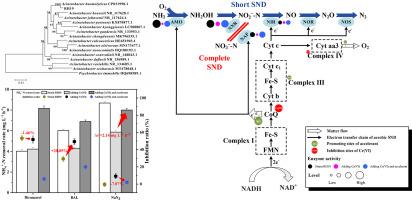缓解Cr(Ⅵ)对溶血不动杆菌RH19同时硝化和反硝化过程的胁迫
IF 12.4
1区 环境科学与生态学
Q1 ENGINEERING, ENVIRONMENTAL
引用次数: 0
摘要
铬(Ⅵ)和氨的生物修复被认为是一种替代化学和物理方法的前景广阔、成本效益高的方法。然而,由于较高的溶解度,铬(Ⅵ)会抑制胞内/胞外电子(IET/EET)传递或硝化和反硝化酶的活性,从而抑制脱氮。在这项研究中,我们分离出了一种同时硝化和反硝化(SND)微生物溶血不动杆菌 RH19,它能够取代氧气以氮氧化物/氨作为电子受体,并研究了一种联合促进剂(半胱氨酸、生物素和细胞分裂素)来缓解 Cr(Ⅵ)胁迫。呼吸链抑制实验和中间产物表明,菌株 RH19 具有完整的细胞内呼吸链。尽管复合物Ⅳ受到抑制,有利于电子转移到氮氧化物--N,但 SND 过程在 Cr(Ⅵ)的作用下仍受到极大抑制,这可能是由于电子受体(硝化/营养/反硝化酶)的电子流较低所致。相反,促进剂主要在负责向 AMO 和 NAP 转移电子的 CoQ 位点以及复合物Ⅳ(与有氧反硝化有关)上对 Cr(Ⅵ)进行解毒,从而有利于通过直接将亚硝酸盐转化为氮气的捷径 SND(SSND,NH4+-N→NH2ON→NO2--N→N2)过程。此外,促进剂还能刺激 c-Cyts 和黄素单核苷酸(FMN)的分泌,从而改善电子传递。总之,该研究强调了加速剂在 Cr(Ⅵ) 应力下的 SND 过程中的缓解机制,并深化了处理共存污染物的 SND 理论基础。本文章由计算机程序翻译,如有差异,请以英文原文为准。


The alleviation of Cr(Ⅵ) stress on simultaneous nitrification and denitrification process of Acinetobacter haemolyticus RH19
Bioremediation of Cr(Ⅵ) and ammonia is considered as a promising and cost-effective alternative to chemical and physical methods. However, Cr(Ⅵ) could inhibit nitrogen removal by inhibiting intra-/extracellular electron (IET/EET) transfer or nitrifying and denitrifying enzymes activity due to its higher solubility. In this study, we isolated a simultaneous nitrification and denitrification (SND) microorganism Acinetobacter haemolyticus RH19, capable of outcompeting oxygen to take nitrogen oxides/ammonia as electron acceptors, and studied a combined accelerant (cysteine, biotin and cytokinin) to relive the Cr(Ⅵ) stress. Respiratory chain inhibited experiments and intermediates showed that strain RH19 had the intact intracellular respiratory chain. Despite the inhibited complex Ⅳ favoring the electrons transfer to NOx−-N, the SND process was still greatly inhibited with Cr(Ⅵ), likely attributed to lower electron flow to the electron acceptors (nitration/nitrition/denitrification enzyme). Instead, the accelerant detoxified Cr(Ⅵ) mainly at CoQ site responsible for electron transfer to AMO and NAP, as well as complex Ⅳ (related with aerobic denitrification), favoring the shortcut SND (SSND, NH4+-N→NH2ON→NO2−-N→N2) process by directly converting nitrite to nitrogen gases. Additionally, accelerant could stimulate the secretion of c-Cyts and flavin mononucleotide (FMN) to improve the electron transfer. Overall, this study highlighted the accelerant-alleviated mechanism in the SND process under Cr(Ⅵ) stress, and deepened the theoretical SND basis for the treatment of co-existing pollutants.
求助全文
通过发布文献求助,成功后即可免费获取论文全文。
去求助
来源期刊

Water Research
环境科学-工程:环境
CiteScore
20.80
自引率
9.40%
发文量
1307
审稿时长
38 days
期刊介绍:
Water Research, along with its open access companion journal Water Research X, serves as a platform for publishing original research papers covering various aspects of the science and technology related to the anthropogenic water cycle, water quality, and its management worldwide. The audience targeted by the journal comprises biologists, chemical engineers, chemists, civil engineers, environmental engineers, limnologists, and microbiologists. The scope of the journal include:
•Treatment processes for water and wastewaters (municipal, agricultural, industrial, and on-site treatment), including resource recovery and residuals management;
•Urban hydrology including sewer systems, stormwater management, and green infrastructure;
•Drinking water treatment and distribution;
•Potable and non-potable water reuse;
•Sanitation, public health, and risk assessment;
•Anaerobic digestion, solid and hazardous waste management, including source characterization and the effects and control of leachates and gaseous emissions;
•Contaminants (chemical, microbial, anthropogenic particles such as nanoparticles or microplastics) and related water quality sensing, monitoring, fate, and assessment;
•Anthropogenic impacts on inland, tidal, coastal and urban waters, focusing on surface and ground waters, and point and non-point sources of pollution;
•Environmental restoration, linked to surface water, groundwater and groundwater remediation;
•Analysis of the interfaces between sediments and water, and between water and atmosphere, focusing specifically on anthropogenic impacts;
•Mathematical modelling, systems analysis, machine learning, and beneficial use of big data related to the anthropogenic water cycle;
•Socio-economic, policy, and regulations studies.
 求助内容:
求助内容: 应助结果提醒方式:
应助结果提醒方式:


